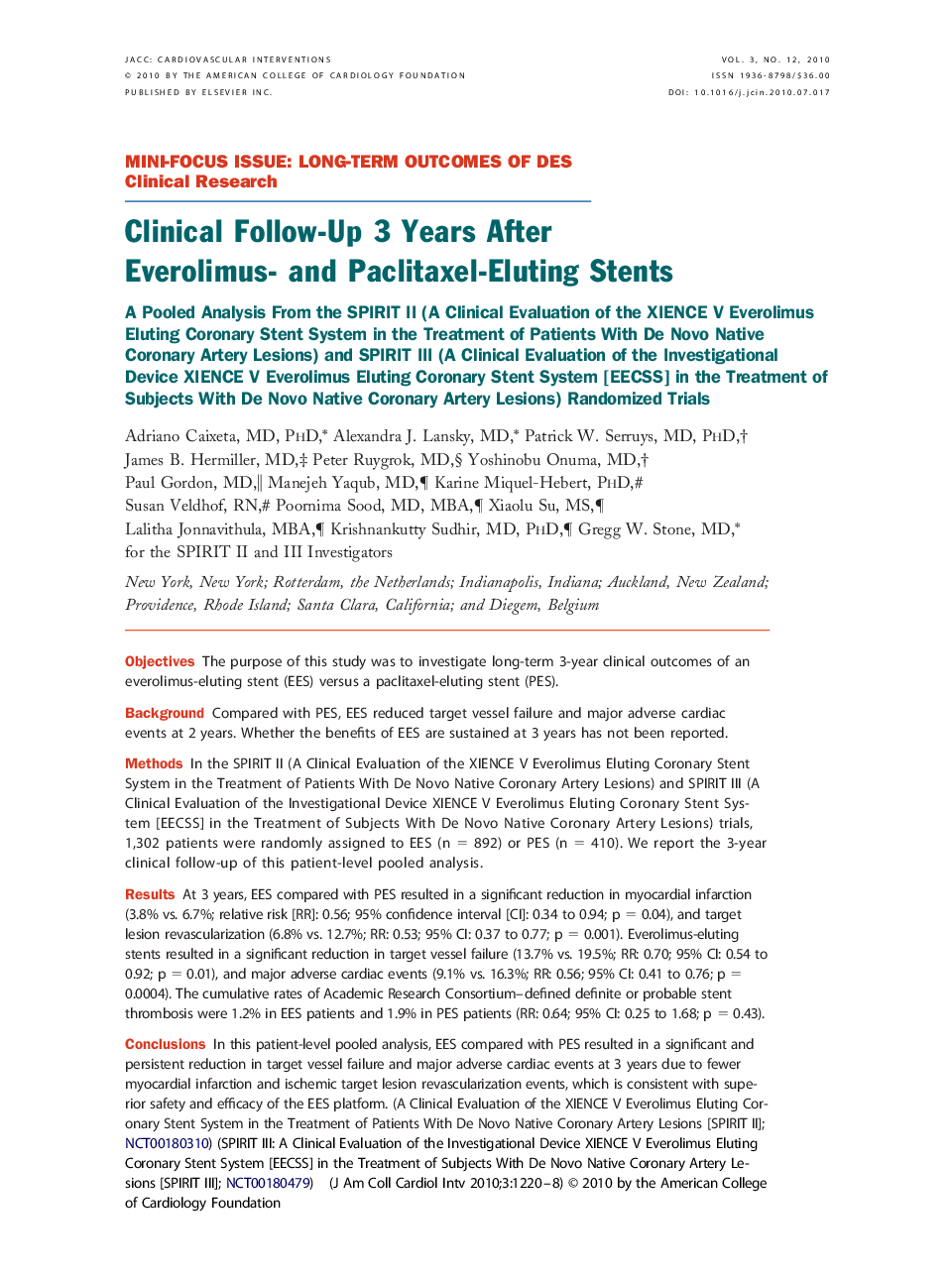| کد مقاله | کد نشریه | سال انتشار | مقاله انگلیسی | نسخه تمام متن |
|---|---|---|---|---|
| 2941980 | 1177095 | 2010 | 9 صفحه PDF | دانلود رایگان |

ObjectivesThe purpose of this study was to investigate long-term 3-year clinical outcomes of an everolimus-eluting stent (EES) versus a paclitaxel-eluting stent (PES).BackgroundCompared with PES, EES reduced target vessel failure and major adverse cardiac events at 2 years. Whether the benefits of EES are sustained at 3 years has not been reported.MethodsIn the SPIRIT II (A Clinical Evaluation of the XIENCE V Everolimus Eluting Coronary Stent System in the Treatment of Patients With De Novo Native Coronary Artery Lesions) and SPIRIT III (A Clinical Evaluation of the Investigational Device XIENCE V Everolimus Eluting Coronary Stent System [EECSS] in the Treatment of Subjects With De Novo Native Coronary Artery Lesions) trials, 1,302 patients were randomly assigned to EES (n = 892) or PES (n = 410). We report the 3-year clinical follow-up of this patient-level pooled analysis.ResultsAt 3 years, EES compared with PES resulted in a significant reduction in myocardial infarction (3.8% vs. 6.7%; relative risk [RR]: 0.56; 95% confidence interval [CI]: 0.34 to 0.94; p = 0.04), and target lesion revascularization (6.8% vs. 12.7%; RR: 0.53; 95% CI: 0.37 to 0.77; p = 0.001). Everolimus-eluting stents resulted in a significant reduction in target vessel failure (13.7% vs. 19.5%; RR: 0.70; 95% CI: 0.54 to 0.92; p = 0.01), and major adverse cardiac events (9.1% vs. 16.3%; RR: 0.56; 95% CI: 0.41 to 0.76; p = 0.0004). The cumulative rates of Academic Research Consortium–defined definite or probable stent thrombosis were 1.2% in EES patients and 1.9% in PES patients (RR: 0.64; 95% CI: 0.25 to 1.68; p = 0.43).ConclusionsIn this patient-level pooled analysis, EES compared with PES resulted in a significant and persistent reduction in target vessel failure and major adverse cardiac events at 3 years due to fewer myocardial infarction and ischemic target lesion revascularization events, which is consistent with superior safety and efficacy of the EES platform. (A Clinical Evaluation of the XIENCE V Everolimus Eluting Coronary Stent System in the Treatment of Patients With De Novo Native Coronary Artery Lesions [SPIRIT II]; NCT00180310) (SPIRIT III: A Clinical Evaluation of the Investigational Device XIENCE V Everolimus Eluting Coronary Stent System [EECSS] in the Treatment of Subjects With De Novo Native Coronary Artery Lesions [SPIRIT III]; NCT00180479)
Journal: JACC: Cardiovascular Interventions - Volume 3, Issue 12, December 2010, Pages 1220–1228